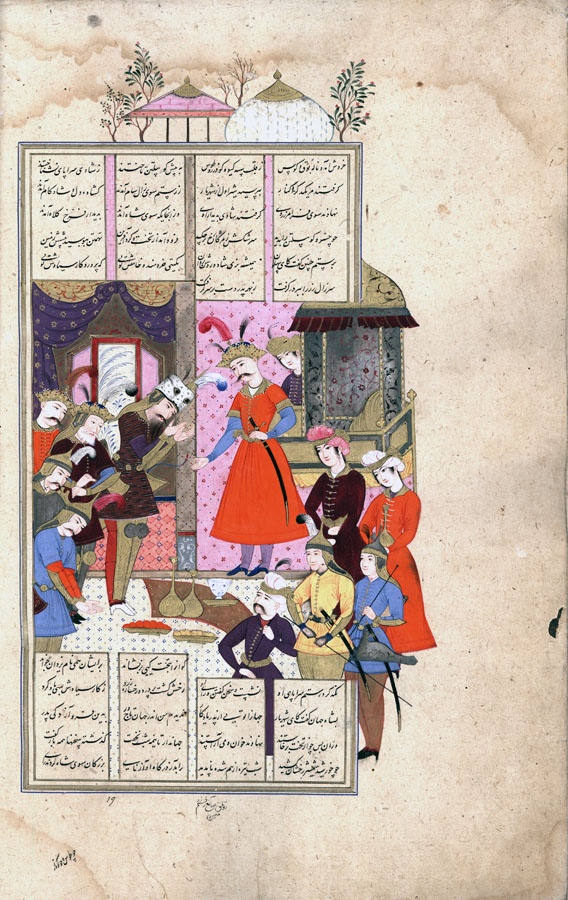Rostam and Zāl before Kay Ḵosrow
The painting depicts Kay Ḵosrow in the upper right-center, shortly after having become shah. He stands in front of his throne with one arm extended welcoming a delegation of nobles. He wears a long red coat, and a jewel-studded crown with the black emblem of kingship and feathers. Behind him, to the left of the throne, is an attendant wearing a turban. A tiled column divides the composition in two halves, and on the left side is the delegation of five nobles, all of whom stand with their arms extended, palms up, in a gesture of obeisance. Foremost among them is Rostam, identified by his familiar tiger skin coat and leopard skin headdress. Just behind him, is Rostam’s father Zāl, now an elderly warrior, but still recognizable by his white hair. The three remaining nobles are not easily identified, but would be according to the text, Rostam’s son Farāmarz, Ṭus, and Gudarz. In the lower right another group of five personage includes, from top to bottom, two attendants with their hands clasped before them, two helmetted warriors, and another dignitary, perhaps an advisor, also wearing a turban. On the floor in the foreground are two long necked flacons and three dishes with fruit. The setting is the interior of a tiled royal palace. On the far right is the covered throne, and in the left background, behind the nobles, a second room with a tripart window and drapery.
There are four columns of text above and below the painting. At the top, two columns are comprised of six lines each, and the remaining columns of five lines. The bottom columns are comprised of four or five lines respectively, but juxtaposed with the top columns, so that overall each column top and bottom has an equal number of lines. A rectangular frame encloses painting and text, except on the right side where the composition spills over into the margin. As a consequence, the frame is omitted on the right side between the upper and lower text blocks. In addition, a dome, a pavilion, and the branches of four trees violate the frame and protrude into the upper margin. The painting is signed in the lower margin, in miniscule characters in Moʿin’s hand: ze towfiq ṣānʿe raqam zad moʿin (drawn with the grace of the maker, by the most humble Moʿin). The inscription is not dated.
Painting references:
Welch, AK4_1978, p.90, Ms.22, folio 130v (not ill.), where the miniature is identified as “Rostam and the Iranians pay homage to Kai Kāvus”.
Text references:
Warner, III, pp.17-19; Mohl, II, p.448; Levy, pp.108-9.
Robert Eng
Last Updated: June 29, 2011 | Originally published: June 29, 2011
